Experimental Investigation of Coherent Vortex Structures in a Backward-Facing Step Flow
Abstract
1. Introduction
2. Methods
2.1. Experimental Model
2.2. Measurement System
2.3. Flow Conditions
3. Results and Discussions
3.1. Vortex Visualization and Definition
3.2. Vortex Motions with Developing Stages
3.3. Vortex Trajectory and Evolution
3.4. Vortex Center and Diameter Distributions
4. Conclusions and Recommendations
Author Contributions
Funding
Acknowledgments
Conflicts of Interest
References
- Eaton, J.K.; Johnston, J.P. A review of research on subsonic turbulent flow reattachment. AIAA J. 1981, 19, 1093–1100. [Google Scholar] [CrossRef]
- Vogel, J.C.; Eaton, J.K.; Adams, E.W. Combined heat transfer and fluid dynamic measurements behind a backward-facing step. Am. Soc. Mech. Eng. 1985, 107, 922–929. [Google Scholar]
- Jacob, M.C.; Guerrand, S.; Juvé, D.; Guerrand, S. Experimental study of sound generated by backward-facing steps under wall jet. AIAA J. 2001, 39, 1254–1260. [Google Scholar] [CrossRef]
- Hu, R.Y.; Wang, L.; Fu, S. Review of backward-facing step flow and separation reduction. Sci. Sin. Phys. Mech. Astro. 2015, 45, 124704. (In Chinese) [Google Scholar]
- Chen, L.; Asai, K.; Nonomura, T.; Xi, G.; Liu, T. A review of backward-facing step (BFS) flow mechanisms, heat transfer and control. Therm. Sci. Eng. Prog. 2018, 6, 194–216. [Google Scholar] [CrossRef]
- Chun, K.B.; Sung, H.J. Visualization of a locally-forced separated flow over a backward-facing step. Exp. Fluids 1998, 25, 133–142. [Google Scholar] [CrossRef]
- Chen, L.; Zhang, X.R.; Okajima, J.; Maruyama, S. Thermal relaxation and critical instability of near-critical fluid microchannel flow. Phys. Rev. E 2013, 87, 043016. [Google Scholar] [CrossRef]
- Baigmohammadi, M.; Tabejamaat, S.; Farsiani, Y. Experimental study of the effects of geometrical parameters, Reynolds number, and equivalence ratio on ethaneoxygen premixed flame dynamics in non-adiabatic cylindrical meso-scale reactors with the backward facing step. Chem. Eng. Sci. 2015, 132, 215–233. [Google Scholar] [CrossRef]
- Shahi, M.; Kok, J.B.W.; Pozarlik, A. On characteristics of a non-reacting and a reacting turbulent flow over a backward facing step (BFS). Int. Commun. Heat Mass Transf. 2015, 61, 16–25. [Google Scholar] [CrossRef]
- Dodaro, G.; Tafarojnoruz, A.; Sciortino, G.; Adduce, C. Modified Einstein sediment transport method to simulate the local scour evolution downstream of a rigid bed. J. Hydraul. Eng. 2016, 142, 04016041. [Google Scholar] [CrossRef]
- Wang, F.F.; Wu, S.Q.; Huang, B. Flow structure and unsteady fluctuation for separation over a two-dimensional backward-facing step. J. Hydrodyn. 2019. [Google Scholar] [CrossRef]
- Roos, F.W.; Kegelman, J.T. Control of coherent structures in reattaching laminar and turbulent shear layers. Aiaa J. 1986, 24, 1956–1963. [Google Scholar] [CrossRef]
- Wee, D.; Yi, T.; Annaswamy, A.; Ghoniem, A.F. Self-sustained oscillations and vortex shedding in backward-facing step flows: Simulation and linear instability analysis. Phys. Fluids 2004, 16, 3361–3373. [Google Scholar] [CrossRef]
- Kostas, J.; Soria, J.; Chong, M. Particle image velocimetry measurements of a backward-facing step flow. Exp. Fluids 2002, 33, 838–853. [Google Scholar] [CrossRef]
- Hudy, L.M.; Naguib, A.; Humphreys, W.M. Stochastic estimation of a separated-flow field using wall-pressure-array measurements. Phys. Fluids 2007, 19, 1093. [Google Scholar] [CrossRef]
- Bradshaw, P.; Wong, F.Y.F. The reattachment and relaxation of a turbulent shear layer. J. Fluid Mech. 1972, 52, 113–135. [Google Scholar] [CrossRef]
- Nadge, P.M.; Govardhan, R.N. High Reynolds number flow over a backward-facing step: Structure of the mean separation bubble. Exp. Fluids 2014, 55, 1657–1678. [Google Scholar] [CrossRef]
- Calomino, F.; Tafarojnoruz, A.; De Marchis, M.; Gaudio, R. Experimental and numerical study on the flow field and friction factor in a pressurized corrugated pipe. J. Hydraul. Eng. 2015, 141, 04015027. [Google Scholar] [CrossRef]
- Calomino, F.; Alfonsi, G.; Gaudio, R.; D’Ippolito, A.; Lauria, A.; Tafarojnoruz, A.; Artese, S. Experimental and numerical study of free-surface flows in a corrugated pipe. Water 2018, 10, 638. [Google Scholar] [CrossRef]
- Armaly, B.F.; Durst, F.J.; Pereira, J.C.F.; Schönung, B. Experimental and theoretical investigation of backward-facing step flow. J. Fluid Mech. 1983, 127, 473–496. [Google Scholar] [CrossRef]
- Simpson, R.L. Review—A review of some phenomena in turbulent flow separation. J. Fluids Eng. 1981, 103, 520–533. [Google Scholar] [CrossRef]
- Tani, I.; Iuchi, M.; Komoda, H. Experimental Investigation of Flow Separation Associated with a Step or a Groove; Aeronautical Research Institute, University of Tokyo: Tokyo, Japan, 1961; p. 364. [Google Scholar]
- McGuinness, M. Flow with a Separation Bubble—Steady and Unsteady Aspects. Ph.D. Thesis, Cambridge Univ., Cambridge, UK, 1978. [Google Scholar]
- Chandrsuda, C. A Reattaching Turbulent Shear Layer in Incompressible Flow. Ph.D. Thesis, Dept. of Aeronautics, Imperial College of Science and Technology, London, UK, 1975. [Google Scholar]
- Kim, J.; Kline, S.J.; Johnston, J.P. Investigation of Separation and Reattachment of a Turbulent Shear Layer: Flow over a Backward-Facing Step; Thermosciences Div., Dept. of Mechanical Engineering, Stanford Univ., Rept. MD-37: Stanford, CA, USA, 1978. [Google Scholar]
- Etheridge, D.W.; Kemp, P.H. Measurements of turbulent flow downstream of a rearward-facing step. J. Fluid Mech. Digit. Arch. 1978, 86, 22. [Google Scholar] [CrossRef]
- Lian, Q.X. An experimental investigation of the coherent structure of the flow behind a backward facing step. Acta Mech. Sin. 1993, 9, 129–133. (In Chinese) [Google Scholar]
- Stevenson, W.H.; Thompson, H.D.; Craig, R.R. Laser velocimeter measurements in highly turbulent recirculating flows. J. Fluids Eng. 1984, 106, 173–180. [Google Scholar] [CrossRef]
- Scarano, F.; Benocci, C.; Riethmuller, M.L. Pattern recognition analysis of the turbulent flow past a backward facing step. Phys. Fluids 1999, 11, 3808–3818. [Google Scholar] [CrossRef]
- Ma, X.; Geisler, R.; Schroder, A. Experimental investigation of separated shear flow under subharmonic perturbations over a backward-facing step. Flow Turbul. Combust. 2017, 99, 71–91. [Google Scholar] [CrossRef]
- Driver, D.M.; Seegmiller, H.L.; Marvin, J.G. Time-dependent behavior of a reattaching shear layer. AIAA J. 1987, 25, 914–919. [Google Scholar] [CrossRef]
- Le, H.; Moin, P.; Kim, J. Direct numerical simulation of turbulent flow over a backward-facing step. J. Fluid Mech. 1997, 330, 349–374. [Google Scholar] [CrossRef]
- Aider, J.; Danet, A.; Lesieur, M. Large-eddy simulation applied to study the influence of upstream conditions on the time-dependant and averaged characteristics of a backward-facing step flow. J. Turbul. 2007, 8, 1–30. [Google Scholar] [CrossRef]
- Kopera, M.A.; Kerr, R.M.; Blackburn, H.M.; Barkley, D. Direct numerical simulation of turbulent flow over a backward-facing step. J. Fluid Mech. 2014. under publication. [Google Scholar]
- Hu, R.Y.; Wang, L.; Fu, S. Investigation of the coherent structures in flow behind a backward-facing step. Int. J. Numer. Methods Heat Fluid Flow 2016, 26, 1050–1068. [Google Scholar] [CrossRef]
- Qi, E.R.; Huang, M.H.; Li, W.; Zhang, X. An experimental study on the 2D time average flow over a backward facing step via PIV. J. Exp. Mech. 2006, 21, 225–232. (In Chinese) [Google Scholar]
- Fan, X.J.; Wu, S.Q.; Zhou, H.; Xiao, X.; Wang, Y. Investigation on the Characteristics of Water Flow over a Backward Facing Step under High Reynolds Number with Particle Image Velocimetry. In Proceedings of the International Conference on Industrial Technology and Management Science, Tianjin, China, 27–28 March 2015. [Google Scholar]
- Ratha, D.; Sarkar, A. Analysis of flow over backward facing step with transition. Front. Struct. Civ. Eng. 2015, 9, 71–81. [Google Scholar] [CrossRef]
- Lugt, H.J.; Gollub, J.P. Vortex Flow in Nature and Technology; Wiley: Hoboken, NJ, USA, 1972. [Google Scholar]
- Robinson, S.K. Coherent motions in the turbulent boundary layer. Annu. Rev. Fluid Mech. 1991, 23, 601–639. [Google Scholar] [CrossRef]
- Deem, G.S.; Zabusky, N.J. Stationary “V-States,” interactions, recurrence, and breaking. Phys. Rev. Lett. 1978, 41, 518. [Google Scholar] [CrossRef]
- Wu, J.Z.; Ma, H.Y.; Zhou, M.D. Introduction to Vorticity and Vortex Dynamics; Advanced Education Press: Beijing, China, 1993; pp. 463–466. [Google Scholar]
- Wang, L. Experimental Study on Coherent Structure in Open-Channel Flow. Ph.D. Thesis, Tsinghua University, Beijing, China, 2009. (In Chinese). [Google Scholar]
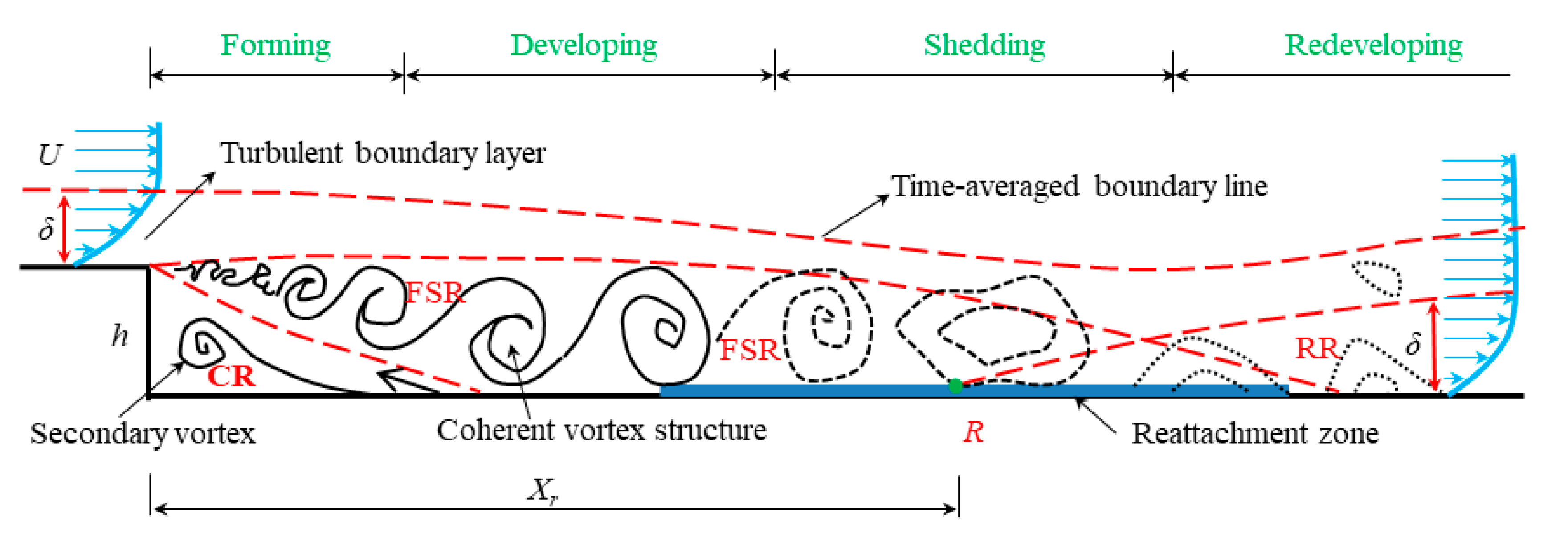
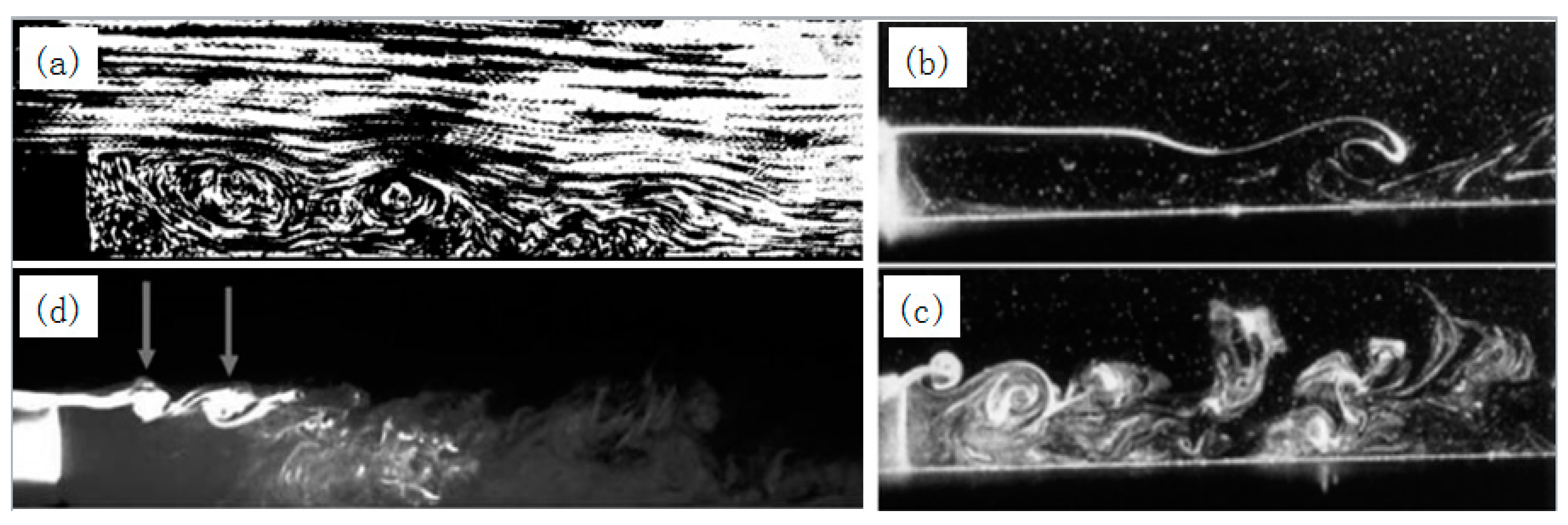
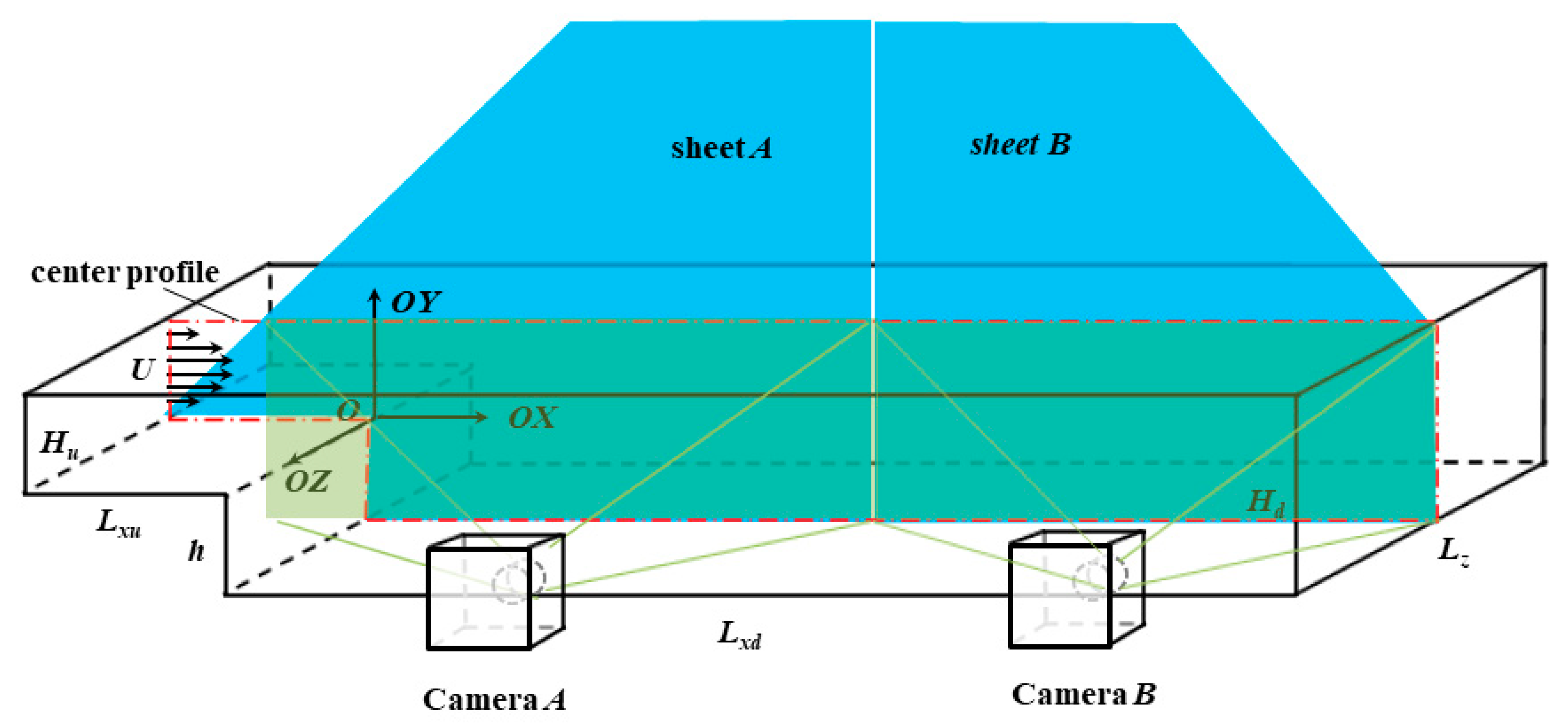
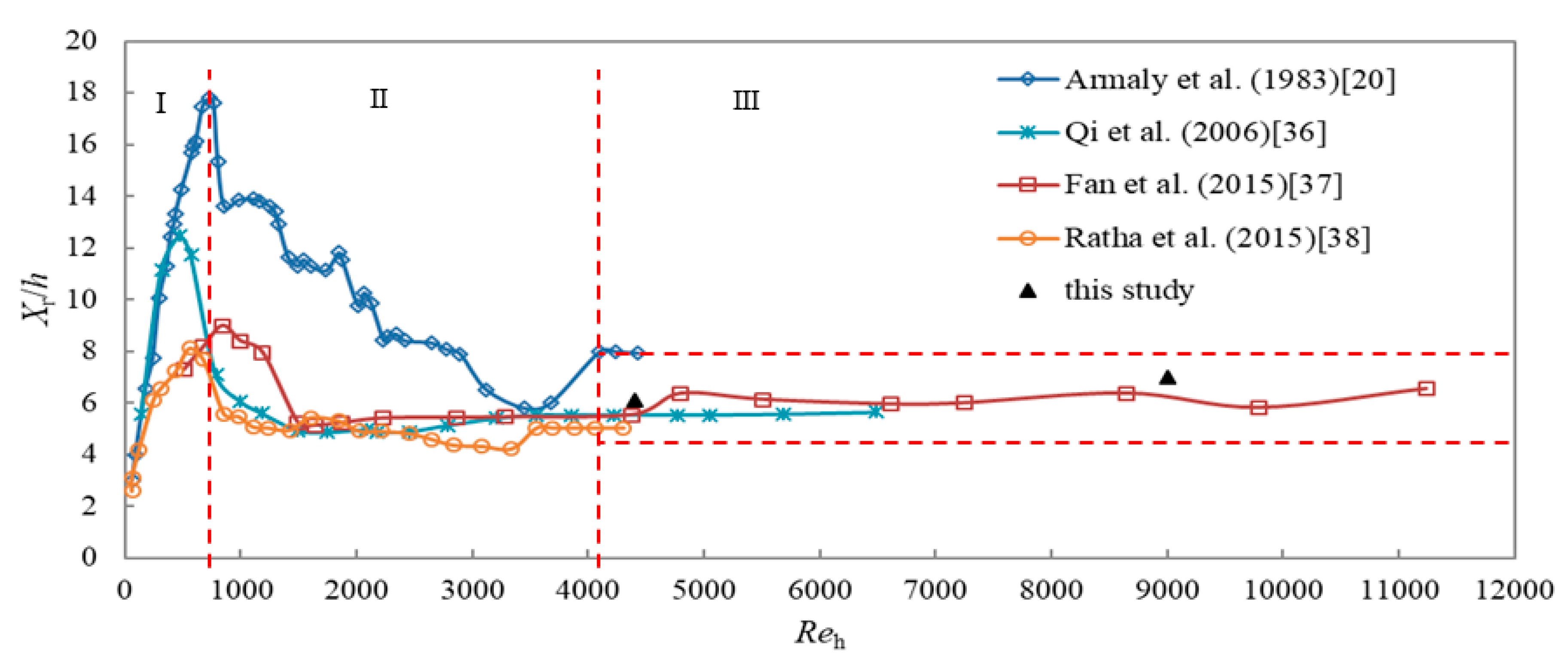
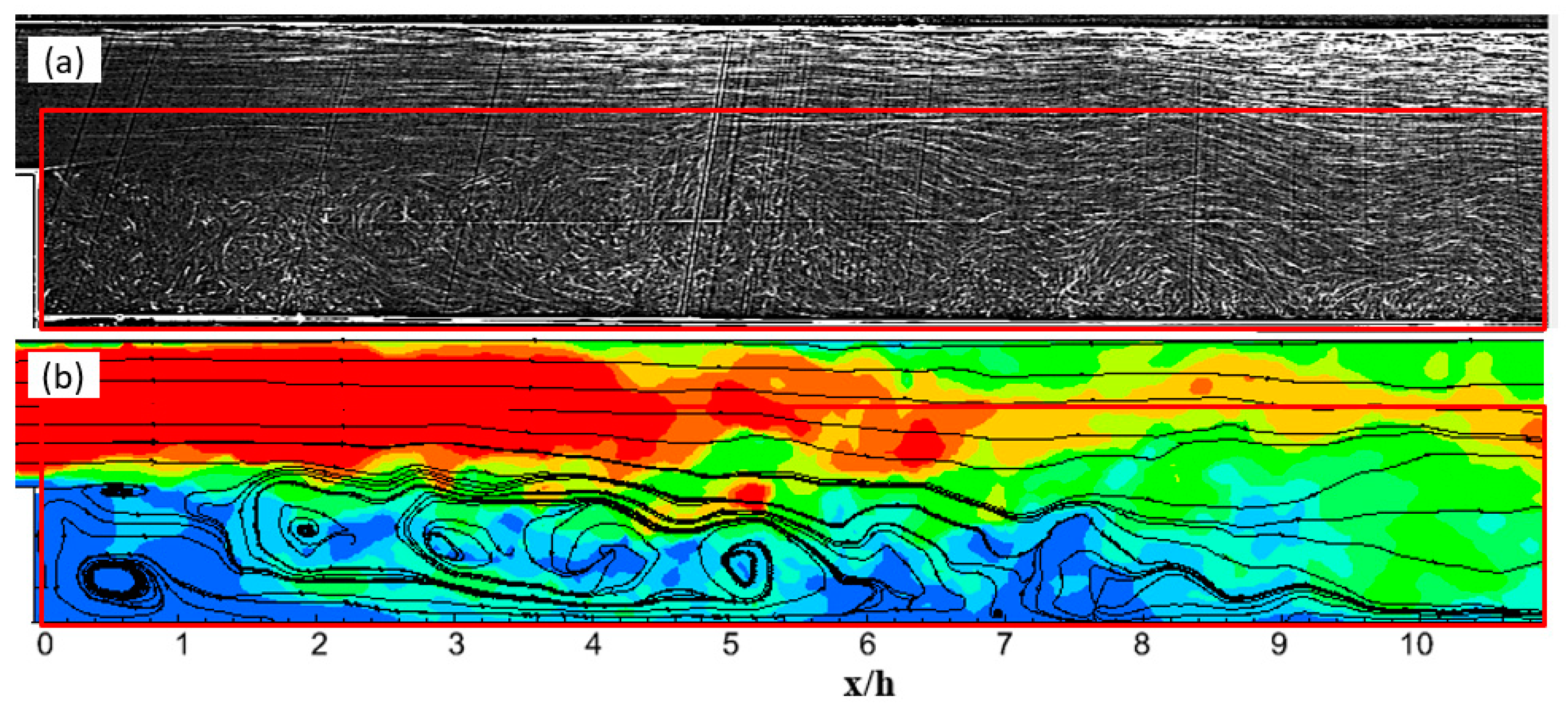

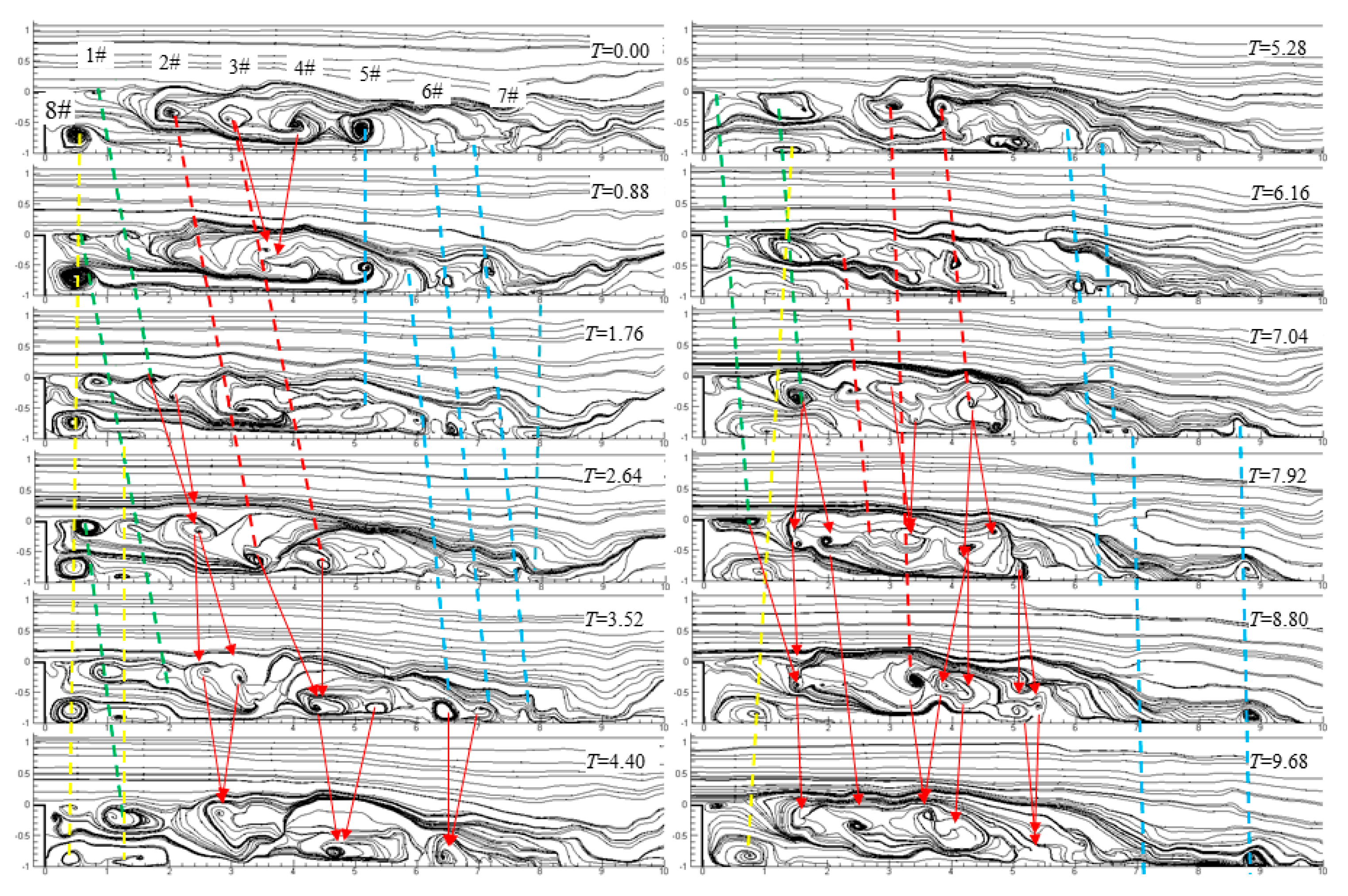

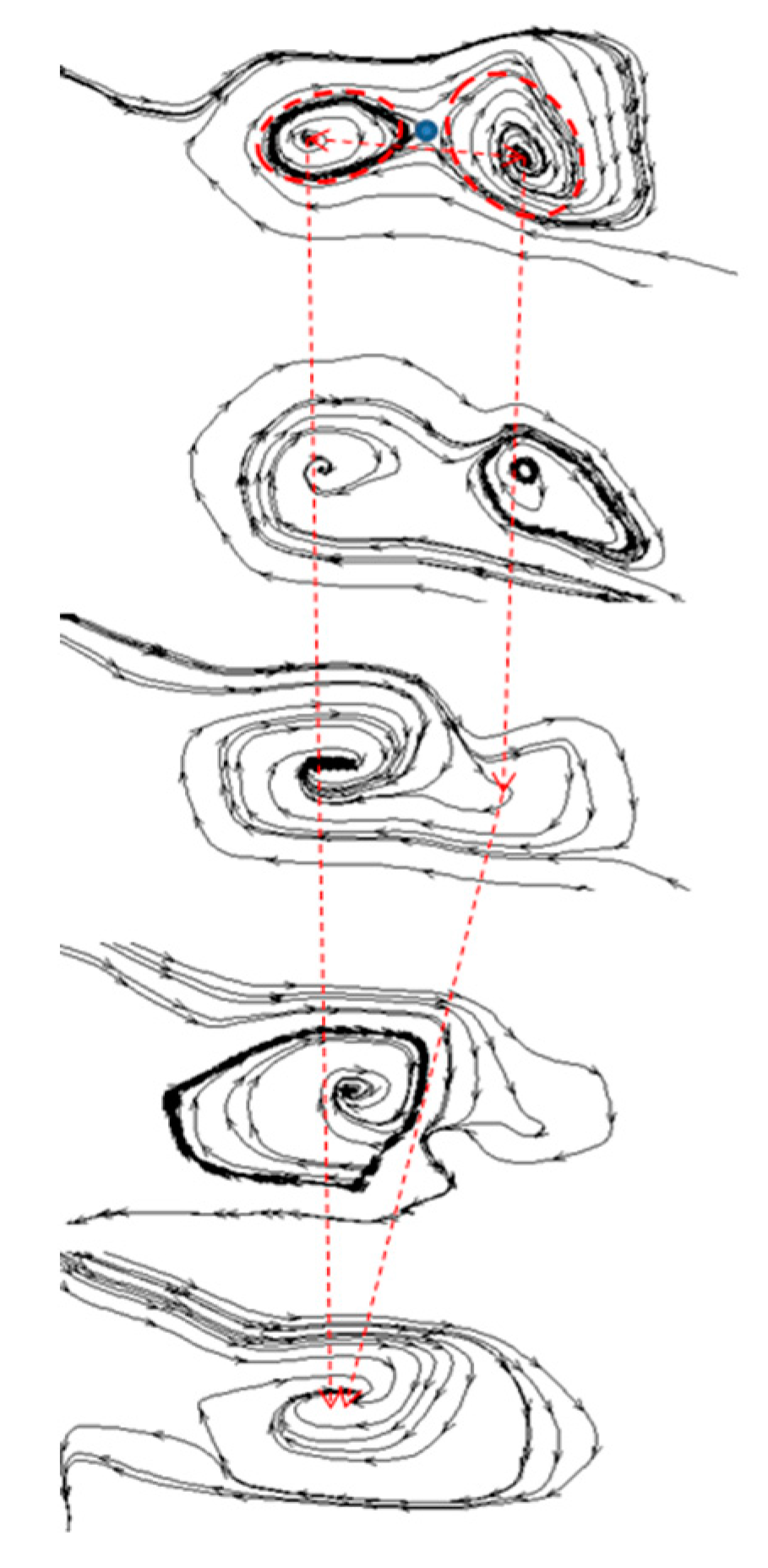
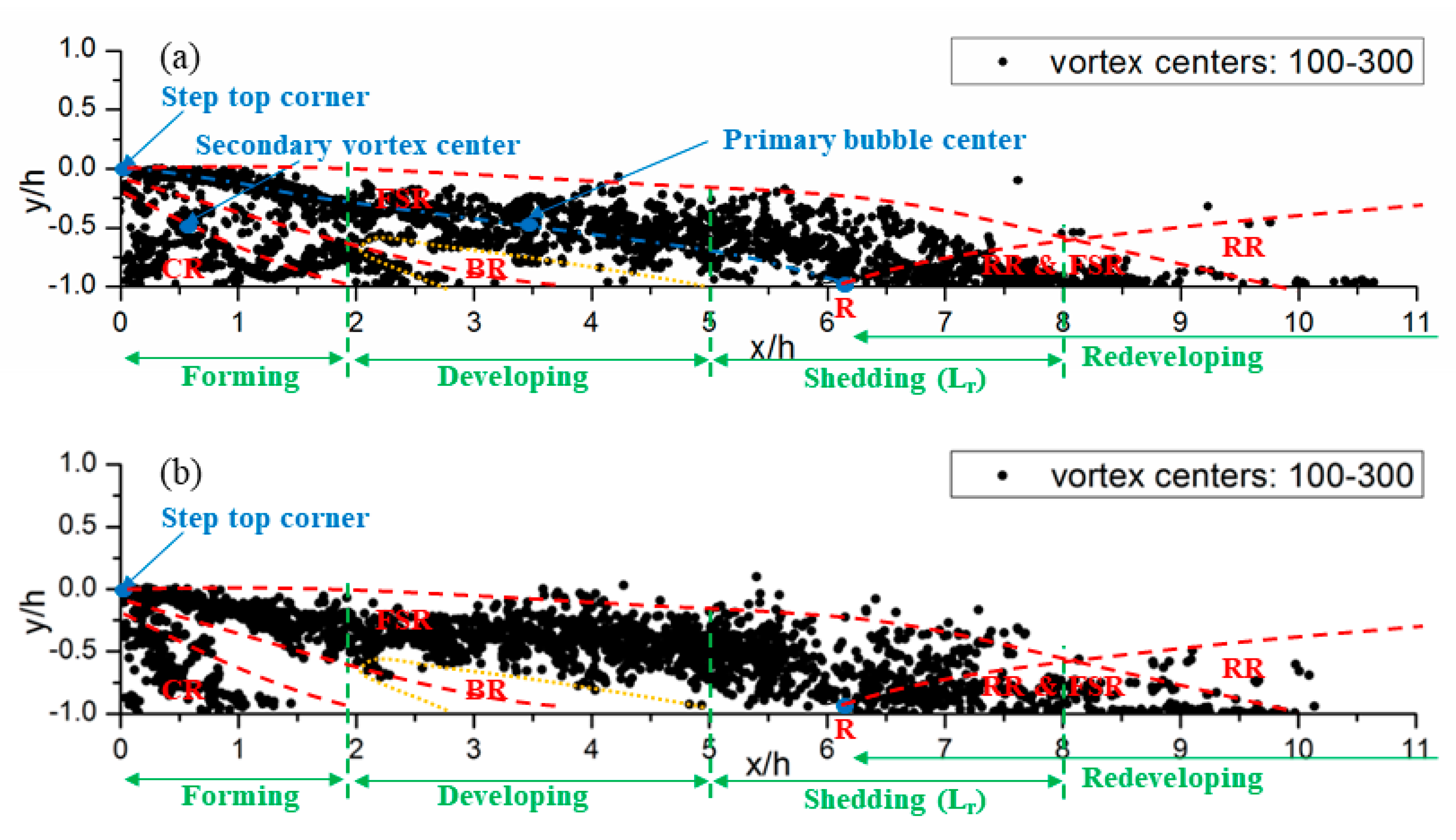
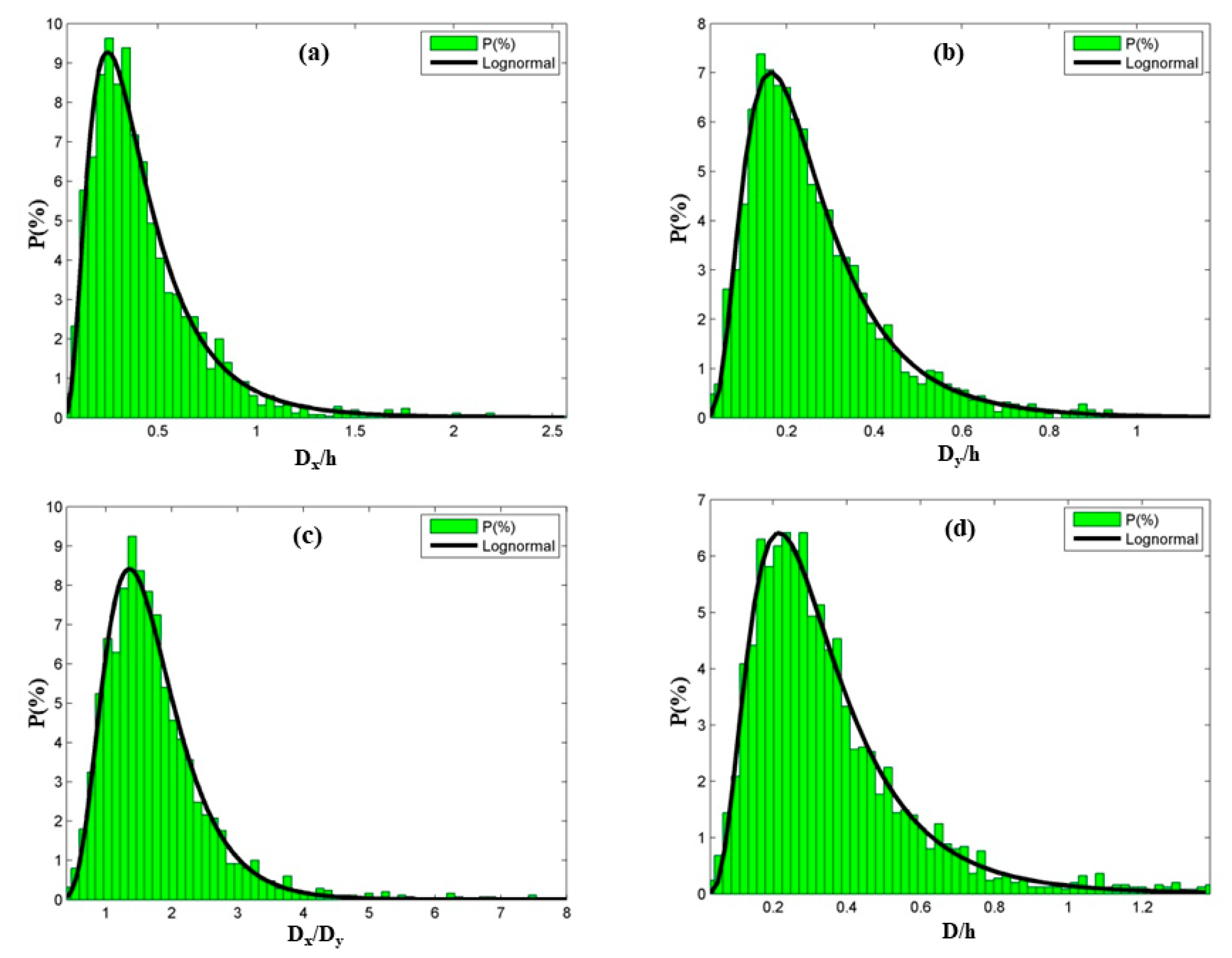
| Parameters | Values | Units |
|---|---|---|
| h | 50 | mm |
| Lxu | 2220 | mm |
| Lxd | 2500 | mm |
| Hu | 50 | mm |
| Hd | 100 | mm |
| Lz | 500 | mm |
| i | 0 | ° |
| Er | 2:1 | - |
| Ar | 10:1 | - |
| h (cm) | Ub (m/s) | Er | Ar | Reh | Xr/h |
|---|---|---|---|---|---|
| 5 | 0.088 | 2:1 | 10 | 4400 | 6.1 |
| 5 | 0.182 | 2:1 | 10 | 9000 | 7.0 |
| Literature | Configuration | Parameter | μ | Exp (μ) | σ |
|---|---|---|---|---|---|
| This study | BFS Reh = 4400 | Dx/h | −1.03 | 0.36 | 0.61 |
| Dy/h | −1.49 | 0.22 | 0.56 | ||
| Dx/Dy | 0.41 | 1.51 | 0.38 | ||
| D/h | −1.22 | 0.29 | 0.56 | ||
| BFS Reh = 9000 | Dx/h | −1.13 | 0.32 | 0.70 | |
| Dy/h | −1.43 | 0.24 | 0.68 | ||
| Dx/Dy | 0.33 | 1.40 | 0.37 | ||
| D/h | −1.26 | 0.28 | 0.68 | ||
| Wang (2009) [43] | TBL Reb = 4677 | Dx/hw | −1.37 | 0.25 | 0.69 |
| Dy/hw | −2.15 | 0.12 | 0.73 | ||
| Dx/Dy | 0.78 | 2.18 | 0.64 |
© 2019 by the authors. Licensee MDPI, Basel, Switzerland. This article is an open access article distributed under the terms and conditions of the Creative Commons Attribution (CC BY) license (http://creativecommons.org/licenses/by/4.0/).
Share and Cite
Wang, F.; Gao, A.; Wu, S.; Zhu, S.; Dai, J.; Liao, Q. Experimental Investigation of Coherent Vortex Structures in a Backward-Facing Step Flow. Water 2019, 11, 2629. https://doi.org/10.3390/w11122629
Wang F, Gao A, Wu S, Zhu S, Dai J, Liao Q. Experimental Investigation of Coherent Vortex Structures in a Backward-Facing Step Flow. Water. 2019; 11(12):2629. https://doi.org/10.3390/w11122629
Chicago/Turabian StyleWang, Fangfang, Ang Gao, Shiqiang Wu, Senlin Zhu, Jiangyu Dai, and Qian Liao. 2019. "Experimental Investigation of Coherent Vortex Structures in a Backward-Facing Step Flow" Water 11, no. 12: 2629. https://doi.org/10.3390/w11122629
APA StyleWang, F., Gao, A., Wu, S., Zhu, S., Dai, J., & Liao, Q. (2019). Experimental Investigation of Coherent Vortex Structures in a Backward-Facing Step Flow. Water, 11(12), 2629. https://doi.org/10.3390/w11122629






